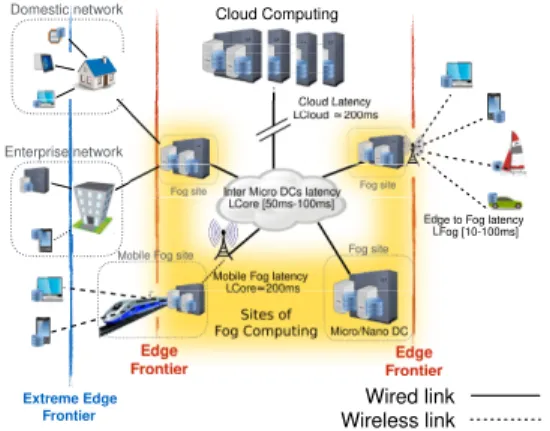HAL Id: hal-01759998
https://hal.archives-ouvertes.fr/hal-01759998
Submitted on 5 Apr 2018
HAL is a multi-disciplinary open access
archive for the deposit and dissemination of
sci-entific research documents, whether they are
pub-lished or not. The documents may come from
teaching and research institutions in France or
abroad, or from public or private research centers.
L’archive ouverte pluridisciplinaire HAL, est
destinée au dépôt et à la diffusion de documents
scientifiques de niveau recherche, publiés ou non,
émanant des établissements d’enseignement et de
recherche français ou étrangers, des laboratoires
publics ou privés.
Improving locality of an object store working in a Fog
environment
Bastien Confais, Adrien Lebre, Benoît Parrein
To cite this version:
Bastien Confais, Adrien Lebre, Benoît Parrein. Improving locality of an object store working in a Fog
environment. 1st Grid’5000-FIT school, Apr 2018, Nice, France. pp.1-2. �hal-01759998�
Improving locality of an object store working in
a Fog environment
Bastien Confais1, Adrien Lebre2, and Benoˆıt Parrein3
1
CNRS, LS2N, UMR 6004, Polytech Nantes, France
2
Inria,LS2N, UMR 6004, Institut Mines T´el´ecom Atlantique, Nantes, France
3
Universit´e de Nantes, LS2N, UMR 6004, Polytech Nantes, France
1
Introduction
The Cloud Computing model relying on few datacenters located far from the users cannot satisfy the new constraints of the Internet of Things (IoT), espe-cially in terms of latency and reactivity. Fog and Edge computing infrastructures have been proposed as an alternative [2]. This new paradigm consists of deploy-ing small data-centers close to the users located at the edge to provide them low-latency computing. Extreme Edge Frontier Frontier Frontier Domestic network Enterprise network Wired link Wireless link Cloud Computing Cloud Latency ge to Fog latency Fog [10-100ms] errrrrr Mo
Fig. 1: Overview of a Cloud, Fog and Edge infrastructure.
Figure 1 shows that the Fog platform is composed of a significant number of sites that can be geographically spread over a large area. IoT devices and users are mobile and are connected to the closest site of Fog Computing. We consider the network latency between the client and the closest Fog site to be lower than the network latency between the Fog sites.
We work on a storage solution for this infrastructure. Our goal is to create a seamless storage experience towards different sites, capable of working in a disconnected mode by containing the network traffic to the sites solliciting the data. We previously proposed to use the object store Interplanetary FileSys-tem [1,4] as a Fog storage sysFileSys-tem because it enables users and IoT devices to write locally on their site but also to automatically relocate the accessed objects on the site they are requested. After improving the locality of IPFS by adding a Scale-Out NAS [3] on each site and proposing to manage location of object in a tree, we evaluated our proposals on the Grid’5000 system by adding virtual network latencies between Fog nodes and clients. We now want to evaluate it in a more realistic environment.
2
Experimentation
We propose to evaluate the performance of the storage system using the couple G5K/FIT. The G5K platform emulates the Fog layer whereas the Edge layer is emulated on the FIT one. Locations like Grenoble, Lyon or Lille are appropriate for our experiment because they host both a G5K and a FIT site, so that we can expect the network latency between IoT nodes and Fog nodes to be low.
a8 node m3 node (ipfs client) iotlab frontend ipfs node g5k frontend m3 node (border router) G5K IoTLab put/get object
g5k site frontend
ssh t unnel
Fig. 2: General architecture of our experiment and interconnection between the Grid’5000 and the FIT platforms.
Figure 2 shows the general topology used for the experiment. We developed a RIOT application to enable IoT nodes to access an IPFS server. The scenario consists in reading a value from a sensor, and storing it in an object of the IPFS server located on the Fog. The challenge for a such scenario is to connect the two platforms. Reaching the G5K platform from the IoT node is not easy, because G5K nodes and FIT nodes are connected to the Internet through IPv4-NAT and the G5K platform does not provide any IPv6 connectivity. Because of the lack of end-to-end IP connectivity between the two platforms, we encapsulate messages in SSH tunnels between a A8-node on the FIT platform and the IPFS node. Instead of accessing directly the IPFS node (plain arrow), the client accesses it from the introduced A8-node that acts like a proxy (dashed arrow). This solution works but is not ideal not only because the tunnel degrades the performance but also because the IP routing is not direct and the path from the two platforms in Grenoble goes through Sophia, increasing the network latency.
3
Conclusion
This experiment was one of the first involving simultaneously the two platforms and we pointed out the difficulties to interconnect them. Once these problems will be solved, we plan to perform a more advanced scenario involving node mobility or the possibility for a node to choose the Fog site to use.
References
1. Benet, J.: IPFS - Content Addressed, Versioned, P2P File System. Tech. rep., Pro-tocol Labs, Inc. (2014)
2. Bonomi, F., Milito, R., Zhu, J., Addepalli, S.: Fog Computing and Its Role in the Internet of Things. In: Proceedings of the First Edition of the MCC Workshop on Mobile Cloud Computing. MCC ’12 (2012)
3. Confais, B., Lebre, A., Parrein, B.: An object store service for a Fog/Edge Comput-ing infrastructure based on ipfs and a scale-out NAS. In: 2017 IEEE 1st International Conference on Fog and Edge Computing (ICFEC). Madrid, Spain (2017)
4. Confais, B., Lebre, A., Parrein, B.: Performance Analysis of Object Store Systems in a Fog and Edge Computing Infrastructure, pp. 40–79. Springer Berlin Heidelberg, Berlin, Heidelberg (August 2017)

